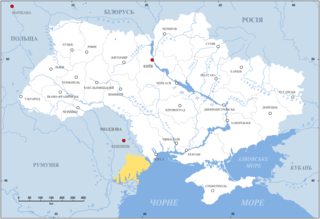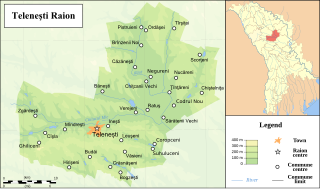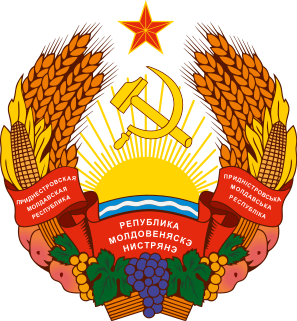
Bessarabia is a historical region in Eastern Europe, bounded by the Dniester river on the east and the Prut river on the west. About two thirds of Bessarabia lies within modern-day Moldova, with the Ukrainian Budjak region covering the southern coastal region and part of the Ukrainian Chernivtsi Oblast covering a small area in the north.

Moldavia is a historical region and former principality in Central and Eastern Europe, corresponding to the territory between the Eastern Carpathians and the Dniester River. An initially independent and later autonomous state, it existed from the 14th century to 1859, when it united with Wallachia as the basis of the modern Romanian state; at various times, Moldavia included the regions of Bessarabia, all of Bukovina and Hertza. The region of Pokuttya was also part of it for a period of time.

Orhei, also formerly known as Orgeev, is a city, municipality and the administrative centre of Orhei District in the Republic of Moldova, with a population of 21,065. Orhei is approximately 40 kilometres north of the capital, Chișinău.

According to the Moldovan law on territorial administrative organisation, Moldova is divided administratively into the following administrative territorial units: districts, cities/towns and villages. The administrative territorial organization of Moldova is made on 2 levels:
- villages (communes), sectors and cities/towns (municipii) constitute the first level,
- districts, Chișinău municipality, Bălți municipality and Bender municipality constitute the second level.

Budjak or Budzhak, historically known as Bessarabia until 1812, is a historical region in Ukraine and Moldova. Lying along the Black Sea between the Danube and Dniester rivers, this sparsely populated multi-ethnic 600,000-people region of 13,188 km2 is located in the southern part of historical Bessarabia. Nowadays, the larger part of the region is included in Ukraine's Odessa Oblast, while the rest is included in the southern districts of Moldova. The region is bordered to the north by the rest of Moldova, to the west and south by Romania, and to the east by the Black Sea and the rest of Ukraine.

Cimișlia is a town located in the southern part of Moldova situated on the banks of the Cogâlnic River, between the capital of Chișinău and the autonomous territorial unit of Gagauzia. Cimişlia had a population of 11,997 according to the 2014 census. The town is also the seat/administrative center of Cimișlia District. It also administers three villages s follows: Bogdanovca Nouă, Bogdanovca Veche, and Dimitrovca.
The history of the Jews in Bessarabia, a historical region in Eastern Europe, dates back hundreds of years.
The Mongol invasion of Volga Bulgaria lasted from 1223 to 1236. The Bulgar state, centered in lower Volga and Kama, was the center of the fur trade in Eurasia throughout most of its history. Before the Mongol conquest, Russians of Novgorod and Vladimir repeatedly looted and attacked the area, thereby weakening the Bulgar state's economy and military power. The latter ambushed the Mongols in the later 1223 or in 1224. Several clashes occurred between 1229–1234, and the Mongol Empire conquered the Bulgars in 1236.

Telenești is a district in central Moldova, with the administrative center at Telenești.

Rezina is a district in the east of Moldova, with the administrative center at Rezina. Rezina is situated on the western bank of the Nistru river. As of 1 January 2011, its population was 52,600.

Orhei is a district in central Moldova, with its administrative center in the city of Orhei. As of 2014 Moldovan Census its population was 101,502.

Strășeni is an administrative district in the central part of Moldova. Its administrative center and leading city is Strășeni. As of 1 January 2011, its population was 91,100. The other principal town is Bucovăț, 26 km (16 mi) to the north of the Moldovan capital. Otherwise the district is divided between rural communities.

The political status of Transnistria, a self-proclaimed state on the internationally recognized territory of Moldova, has been disputed since the Transnistrian declaration of independence on 2 September 1990. This declaration sought to establish a Soviet Socialist Republic that would be independent from local Moldovan authority. Following the breakup of the Soviet Union and Moldova's own declaration of independence in 1991, the Pridnestrovian Moldavian Soviet Socialist Republic (PMSSR) was transformed into the Pridnestrovian Moldavian Republic (PMR). However no United Nations member country recognizes the PMR's independence.

Rezina is a city in Moldova and the capital of Rezina District. Three villages are administered by the city: Boşerniţa, Ciorna and Stohnaia.

The Dubăsari District is a district in the east of Moldova, with the administrative center at Cocieri. As of January 1, 2011, its population was 35,200. This does not include the 715 people that live in the village of Roghi, which is controlled by the breakaway Tiraspol authorities. Dubăsari means ferry-arks.

Isacova is a village in Orhei District, Moldova.

Ivancea is a commune in Orhei District, Moldova. It is composed of three villages: Brănești, Furceni and Ivancea.
Puțintei is a commune in Orhei District of Moldova. It is composed of three villages: Dișcova, Puțintei and Vîprova.

Seliște is a commune in Orhei District, Moldova. It is composed of three villages: Lucășeuca, Mana and Seliște.

Old Orhei is a Moldovan historical and archaeological complex located in Trebujeni, which is approximately 60 kilometres (37 mi) north-east of Chişinău on the Răut River in the Republic of Moldova.
















